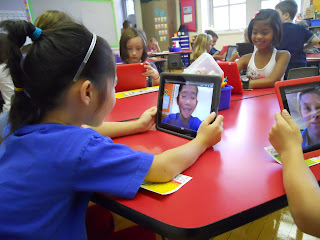
In 2006, our school participated in a state-wide laptop initiative. When the MacBooks with the iSight cameras arrived, at first we saw the camera as a convenience but not necessarily a transformative change. What we soon came to realize was that sometimes, increased convenience in a busy classroom of 30 children CAN be a transformative change! Having the camera always ready, always available, and seamlessly integrated with publishing and media tools makes it possible for students to document learning, create media, and capture their world at a moment's notice. Can you do this with a separate digital camera? Of course. But is it dramatically easier with a built-in camera? You bet it is. Anytime, anywhere access makes a difference with all technology, and a camera is no exception.
The addition of a camera with the iPad 2 is an even bigger deal. To use the MacBook's camera, the photography or video subject has to be positioned in front of the computer. With the iPad dual cameras, the subject can be literally anywhere. Students can capture anything in their learning environment and then podcast, write, draw, or blog about it.
The camera also makes a difference when it comes to assessment. Here's an example: first grade students in Kristin Ziemke's classroom were sorting books into fiction and non-fiction. Kristin needed to know who understood that difference. Kids snapped photos of their piles of books and e-mailed them to her. Voila -- not only does Kristin now know who accomplished this task, but she has simple, authentic data that she can keep and refer to later. In the past, she would have had to rush around to get to all of her students and assess their efforts, and the direct evidence of learning would have been lost the second the students cleaned up their tables.
Think of all the other learning moments students can capture with an iPad camera. Experiments, demonstrations, math manipulative configurations, models, posters -- anything that shows learning and understanding can be documented. When photos are brought into Pages, Keynote, iMovie, or SonicPics, they can become part of a richer reflection that includes text or audio. Those reflections provide authentic information about student understanding and can be captured throughout the year to show growth. The ease and accessibility of the built-in camera makes it possible to weave multimedia assessment throughout the learning day, and it also puts some of the power of documentation and assessment in the hands of the students themselves. Did you do something today you are proud of? Did you overcome a challenge you have had in your learning? Did you finish a book that was especially challenging? Take a picture. Write about it. Talk about it. Those moments are important in the life of a learner, and with a built-in camera, those moments can be saved and shared.
Great ideas! We, too, have found the camera on the iPad to be priceless. Our best use to date, would be the seriousness of the students when we asked the students to "teach your parents" through video on how to solve algebraic equations.
ReplyDeleteIn addition, having the students post daily in class work on their professional blogs has provided me a way to informally assess. Students are not able to hide in their notebook anymore.
Look forward to hearing more about what you do. You can found all that we are doing with iPads in our educational setting at http://www.iPaddiction.blogspot.com